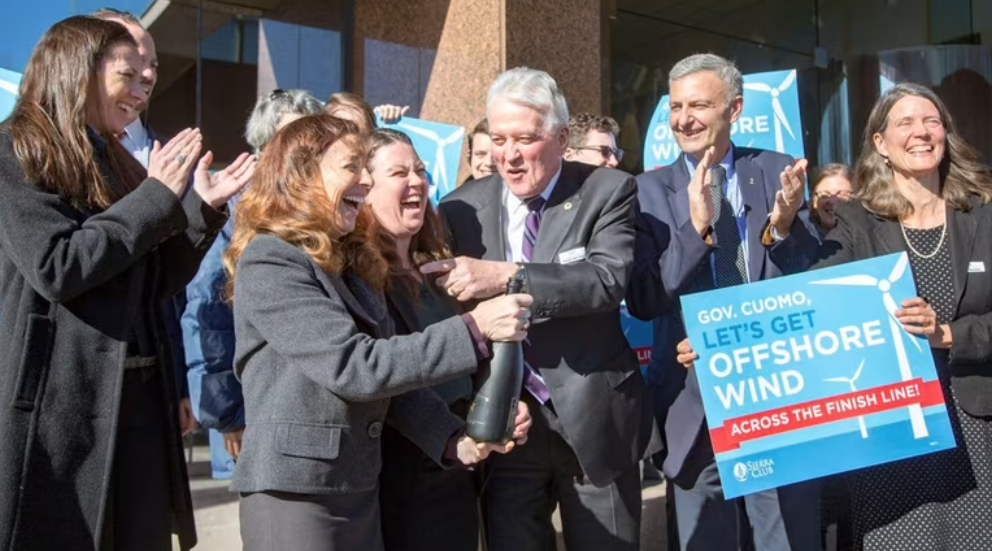Wind farm project approved by LIPA trustees

Adrienne Esposito, second from left, and environmentalists from the Offshore Wind Coalition celebrate and cheer as LIPA trustees voted to approve a 15-turbine wind farm on Wednesday, Jan. 25, 2017. The Deepwater Wind project would be located off the Rhode Island coast, 30 miles from Montauk Point, and connect to Long Island at East Hampton via an undersea cable. Credit: Howard Schnapp
LIPA trustees unanimously approved a resolution to finalize a contract for an offshore wind farm 30 miles from Montauk Point, a $740 million project that could start producing energy by the end of 2022.
Amid widespread support from environmental and labor groups, trustees on Wednesday voted 9-0 to start the long process of studying, permitting and building the 15-turbine array in waters off the Rhode Island coast between Block Island and Martha’s Vineyard. The project by developer Deepwater Wind would connect to Long Island at East Hampton via a 50-mile undersea cable.
LIPA chief Tom Falcone called the initiative a “gateway project” that “is not our last.” LIPA also is considering a separate 210-megawatt project by Deepwater. He pointed to lower costs and an improved federal process, in explaining the decision to move forward.
“We have the right project at the right location,” he said, adding it would have “no visual impacts.”
LIPA in 2007 rejected as too costly a $700 million, 40-turbine project three to five miles from Jones Beach that opponents — including then-developer Donald Trump — called too close to shore. LIPA also handed off another project it had developed with Con Edison and the New York Power Authority to the state, before Norway-based Statoil recently won the right to lease that project, 11.5 miles from Jones Beach.
Gov. Andrew M. Cuomo signaled his formal blessing for the LIPA-Deepwater project in his State of the State address earlier this month, weeks after the state unsuccessfully bid for the lease rights won by Statoil. “Today’s decision means cleaner energy, new jobs and fresh momentum as we move aggressively to our goal of 50 percent renewable power by 2030,” Cuomo said of the LIPA approval.
Jeff Grybowski, chief executive of Deepwater Wind, said the $740 million price tag included all elements of the project, “soup to nuts” — from purchase of turbines to laying the 50-mile cable to bring the energy to the South Fork.
Grybowski said the project would employ “hundreds” of Long Islanders through its six-year march to completion, though LIPA cautioned that there were no specific job guarantees in the contract. Construction could start in 2020, Grybowski said.
If certain elements of the project are begun this year, the project would qualify for a 24 percent federal investment tax credit, potentially reducing the developer cost by some $177 million. “Our goal is to qualify for the highest federal tax credit,” Grybowski said, while declining to say whether the contract includes it.
LIPA left open the prospect of prepaying a portion of the contract’s 20-year payments to Deepwater by issuing new debt. Officials declined to provide specific figures on such arrangement. Grybowski stressed that “it’s not something we need or are asking for” to complete the project.
During a board discussion, LIPA presented a slide showing bipartisan support for the project on Long Island from state and local officials. Trustee Matthew Cordaro, who supported the project but raised questions about its costs, noted that an important face was missing from the slide: that of President Donald Trump.
Grybowski later said the company was “very comfortable” that tax credits and federal approvals for the project wouldn’t be held up. Deepwater has a lease for the wind area, but it still needs a permit from the Bureau of Energy Ocean Management, as well as approvals from the U.S. Coast Guard and the U.S. Fish and Wildlife Service, among others. “I think folks in Washington will be very supportive,” he said.
A Trump administration spokeswoman didn’t immediately provide a comment.
